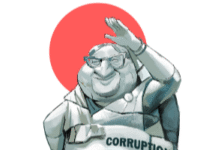I have been wondering about the correct frame of reference for the Projonmo Chottor movement. Although comparisons have been made to Tahrir and Occupy, I think there is a more apt comparison that is closer, both temporally and spatially.
It is the anti-corruption movement in India last year, led by Anna Hazare. Shahbag crowd are not demanding greater economic (OWS) or political (Tahrir) freedom. They are demanding greater punitive measure against a certain group of people (the corrupt in India, war criminals in BD). In both cases, the demands were made to a largely sympathetic government. Even though the Indian Government initially took Hazare in custody, it realized its huge mistake and released him soon afterwards. Moreover, Anna Hazare’s chief lieutenants were mainly people in the pro-Congress, anti-BJP camp, and most of the icons of Shahbag are people in the pro-AL, anti-BNP camp.
Moudud Ahmed may want to rethink his claim that BNP is going to set up similar events of their own. When BJP tried the same in India, this is what happened, according to Wikipedia:
“Satyagrah was going on even in the night of 4 June 2011. Sources informed Baba Ramdev that a huge police force can try to clear Ramlila Ground and if it is not done they can also kill him in a fake encounter or set fire in the tents. At midnight, a huge team of 10,000 officers of the Delhi Police and RAF raided the ground when most of the Satyagrahis were sleeping on the and Ramdev was also sleeping on the dias along with his core group. A large police force lobbed tear gas shells and lathicharged to evict the crowd from 1a.m. to 4 a.m. The tent was set on fire at many places. Cold water was thrown over power generators to create complete darkness to prevent any video recording of the whole attack. However most media persons recorded what was going on.
Police had arranged buses to drop supporters at railway stations and bus stands in advance; had ammunition ready and all the policemen were in battle-gear wearing vests and helmets and kept some mbulances on standby. Ramdev was arrested while attempting to disguise himself in women’s clothing.
Delhi Police forcefully detainedRamdev at Safdargunj Airport in complete isolation for a few hours and then deported him to his Ashram in Haridwar via helicopter.”
So, maybe worth reconsidering.
Hazare’s movement tapered off after the Indian Parliament took up the Lokpal bill, but its message remained very potent. Now that the Bangladeshi Parliament has passed a bill allowing greater scope for the prosecution to appeal, it remains to seen what path Shahbag takes.
On another note, Jamaat has been on the warparth since last week, especially last Friday and then again after the Saydee verdict was delivered. It is unclear what it thinks it will achieve; incidents such as burning the Bangladeshi national flag, destroying a Shahid Minar, or attaching the homes and temple of the Hindu community in Noakhali have rightly been met with universal condemnation. The Bangladeshi media, by and large, have portrayed Jamaat as the exclusive actor behind the violance. Jamaat has claimed that its ranks have been bolstered by the participation of the general populace, as well as other like-minded rightist parties. If the former is correct, given that Economist is calling the aftermath of Sayeedi’s hanging “the worst single day of political violence in the history of modern Bangladesh,” assumably it took a big chunk out of Jamaat’s organizational resources to creat this level of anarchy all across Bangladesh. It shoudn’t be something that Jamaat can recreate at will.
There should be, by definition, only a limited number of individuals upon whom Jamaat can call upon to instigate and perpetrate violence. And after each cycle of violence, this number should decrease through attrition: death, arrest, injury, so on. There are still four more Jamaat leaders whose trials are currently ongoing: Golam Azam, Motiur Rahman Nizami, Ali Ahsan Md Mujahid, and Kamaruzzaman. Assuming each of these four individuals get death sentences, the level of violence instigated by Jamaat should decrease in each iteration, as Jamaat runs out of the individuals who are willing to take this level of risk.
Whether it be black swans or white crows, no good can come out of any interruption in electoral politics. No to violence, and yes to democracy and justice.
Source: Alal O Dulal









